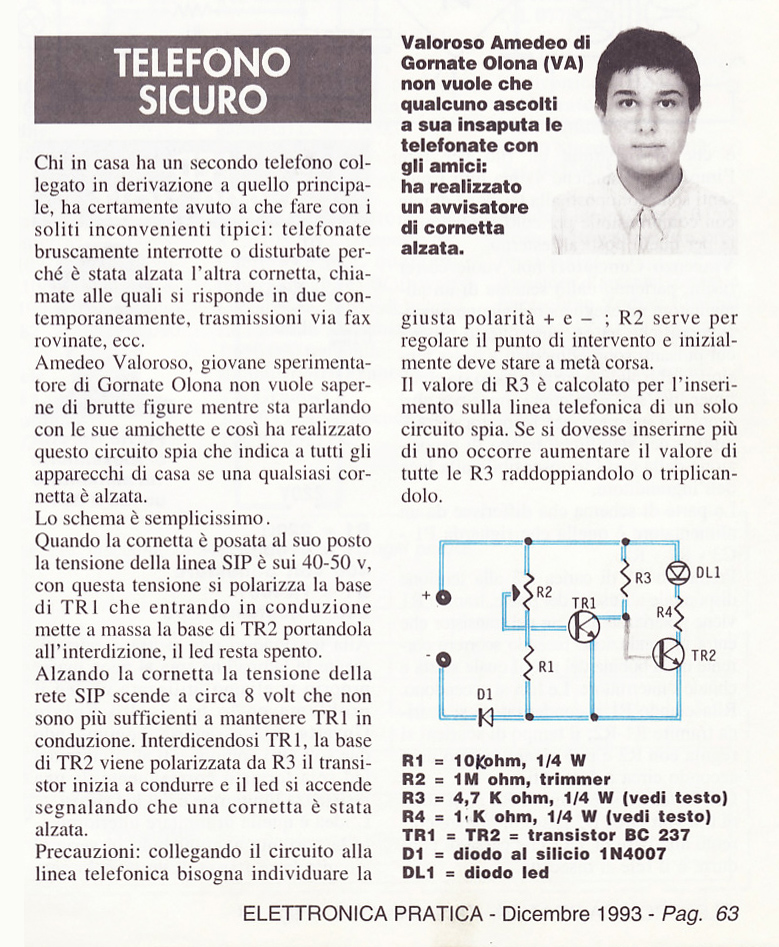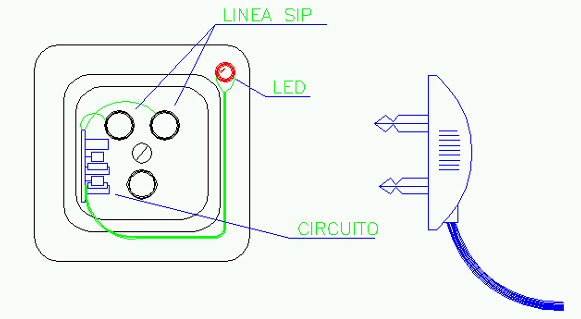SPTEL is a busy telephone line detector, which I designed when I was just over 15 years old: it is an LED that lights up when the telephone line is engaged by a telephone device in conversation. This project of mine was published in the magazine "Elettronica Pratica, December 1993".


SPTEL components
Resistors:
R1 – 10 K ohm, 1/4 W
R2 – 1 M ohm, trimmer
R3 – 4,7 K ohm, 1/4 W (vedi testo)
R4 – 1 K ohm, 1/4 W (vedi testo)
Other:
TR1, TR2 – transistor BC 237
D1 – diodo al silicio 1N4007
DL1 – diodo LED

SPTEL, busy telephone line indicator, description
Per chi, come me, possiede più di un telefono in casa è spesso un problema riuscire a telefonare senza che qualcuno sollevi la cornetta telefonica e cominci a comporre numeri e a parlare, magari escludendo chi stava interloquendo prima, rovinandogli così anche una importante telefonata. Ma non è questo l’unico inconveniente di avere più di un apparecchio sulla linea SIP. Quando suona, può capitare di rispondere in due contemporaneamente. Ma c’è dell’altro: come devo fare per avvisare qualcuno che sto telefonando, per non essere disturbato? Certo, lo si può gridare, ma non è la soluzione ideale per chi possiede una casa grande e dei vicini con le orecchie aperte …
Well, by building this microscopic circuit, a busy phone line detector, you will have a constant alert of the status of the phone line. More precisely: when someone picks up the handset, the indicator lights located in the desired places will light up, alerting you that the phone is already busy. When the phone is free (handset down), the LEDs will turn off.
Sapendo che qualcuno è già al telefono, nessuno si sognerà di alzare il suo ricevitore, a meno che non voglia spiare … Ma a questo punto la luminosità del LED diminuirà, avvisando così di essere ascoltati.
Owning a FAX, the circuit is useful to know if it is still in operation, thus avoiding interfering by raising a handset.
Circuit operation
The principle of operation of this circuit is very simple, and is based on the conduction and interdiction of transistors.
Quando la cornetta del telefono è abbassata, cioè la linea SIP è libera, la tensione presente sulla linea sarà di circa 40-50 Volt. Questa tensione sarà abbassata dal partitore resistivo R2 – R1, restando comunque ad un livello sufficiente per portare in conduzione TR1. TR1 impedirà quindi a R3 di eccitare TR2 (collegando la sua base al negativo), quindi il LED sarà spento.
Alzando la cornetta del telefono (oppure con segreteria, FAX, ecc… in funzione) la tensione presente sulla linea telefonica sarà intorno agli 8 Volt, il partitore resistivo ridurrà la tensione che sarà però insufficiente per portare in conduzione TR1. Con TR1 interdetto, la resistenza R3 potrà portare una debole corrente positiva a TR2, che riuscirà a condurre tensione e ad accendere DL1.
When the phone rings, DL1 flashes fast and brighter.
D1 è necessario per non bruciare TR1 o TR2 quando il telefono suona, e per salvare il circuito se si dovesse invertire la polarità della alimentazione (per stabilire il + o il – della linea SIP è sufficiente usare un tester).

Telephone line busy detector calibration
The calibration of the circuit is simple, as only the R2 trimmer has to be retouched.
Before giving current to the circuit, it is necessary to rotate the slider of R2 halfway through, in order to prevent it from bringing too much current to TR1.
By connecting the circuit to the SIP line, the LED should be turned off (if this does not happen, gradually rotate the slider of R2 towards the positive, until the LED turns off). Raising the phone's handset, the LED will light up and lowering it will turn off (rotate the R2 slider appropriately, if necessary).
If the LED flashes when speaking to the handset, turn the R2 trimmer away from the positive.
Then check if the circuit works correctly with all telephone devices.
Useful tips
Applying a single circuit on the SIP line, R3 can also be 4.7 K ohms, but if you were to install more circuits, it is better to raise its value to 8.2 K ohms or even 10 K ohms, since too much absorption on the line would make the SIP believe that a handset is raised, preventing you from receiving phone calls.
If the brightness of the LED is too low, the value of R4 can be increased from the current 1000 ohms to 820 or 470 ohms (also considering the number of circuits installed, to avoid lowering the volume of the telephone handset too much).

Given the small size of the millefori base, I installed the circuit of the telephone line detector engaged in the phone socket, protruding the LED from a small hole made in its corner.
Project start: May 1993. State: for technical publication.